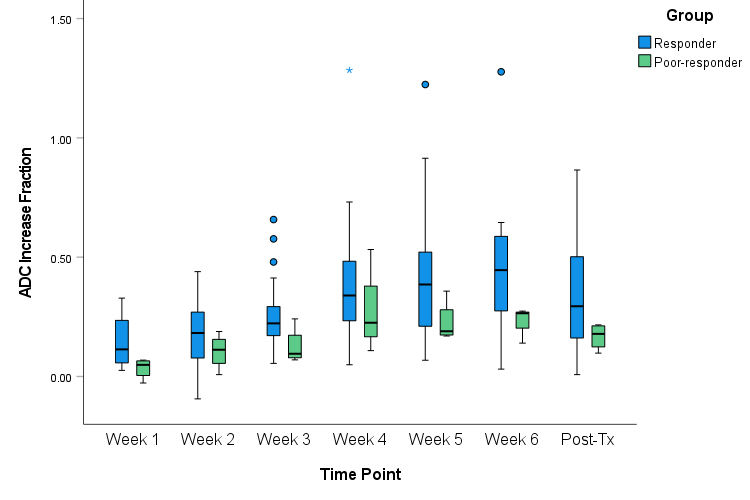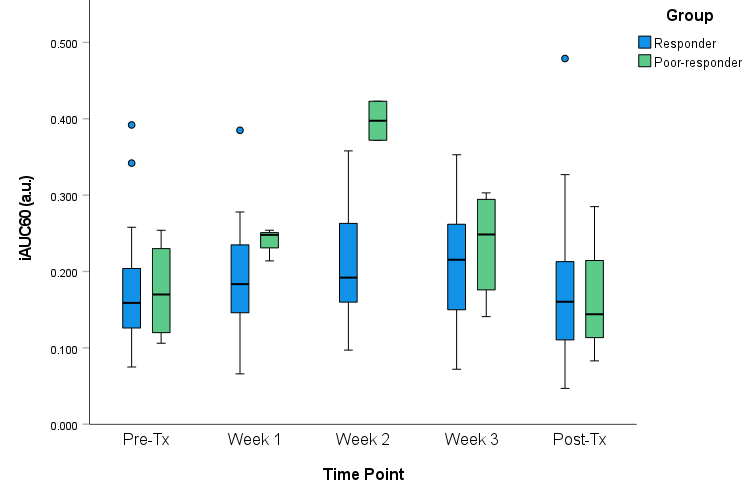Optimal time for early therapeutic response prediction in NPC with multi-parametric MRI
Wing Lun Mui,
China, Hong Kong Special Administrative Region
MO-0957
Abstract
Optimal time for early therapeutic response prediction in NPC with multi-parametric MRI
Authors: Wing Lun Mui1,2, Wing Mui Lee2, Wai Tong Ng2, Ho Fun Lee2, Varut Vardhanabhuti3, Shei Yee Man1, Tsin Tien Chua4, Xin Yuan Guan2
1Hong Kong Sanatorium and Hospital, Department of Radiotherapy, Hong Kong, Hong Kong (SAR) China; 2The University of Hong Kong, Department of Clinical Oncology, Hong Kong, Hong Kong (SAR) China; 3The University of Hong Kong, Department of Diagnostic Radiology, Hong Kong, Hong Kong (SAR) China; 4Hong Kong Sanatorium and Hospital, Department of Medicine, Hong Kong, Hong Kong (SAR) China
Show Affiliations
Hide Affiliations
Purpose or Objective
Physiological changes including perfusion, diffusion and metabolite concentration in tumour occur much earlier than morphological changes. These early changes can be used potentially as the biomarkers for therapeutic response prediction. This study aimed to investigate the optimal time for early therapeutic response prediction with multi-parametric MRI in patients with nasopharyngeal carcinoma (NPC) receiving concurrent chemo-radiotherapy (CCRT).
Material and Methods
Twenty-seven NPC patients (median age 49, range 26-66) were divided into the responder (N=23) and the poor-responder (N=4) groups by their primary tumour post-treatment shrinkages with more or less than 50% volume respectively. Single-voxel proton MR spectroscopy (1H-MRS), diffusion weighted (DW) and dynamic contrast-enhanced (DCE) MRI were scanned with a 1.5T MAGNETOM Aera MR-Simulator (Siemens Healthcare, Erlangen, Germany) at baseline, weekly during CCRT and post-CCRT. The median choline peak in 1H-MRS, the median apparent diffusion coefficient (ADC) in DW-MRI, the median influx rate constant (Ktrans), reflux rate constant (Kep), volume of extravascular-extracellular space per unit volume (Ve); and initial area under the time-intensity curve for the first 60 seconds (iAUC60) in DCE-MRI were compared between the two groups with the Mann-Whitney tests for any significant difference.
Results
In DW-MRI, the percentage increase in ADC from baseline to week 1 for the responders (median 11.39%, IQR 18.13%) was higher than the poor-responders (median 4.91%, IQR 7.86%) (p=0.027, Figure 1). In DCE-MRI, the iAUC60 on week 2 was found significantly higher in the poor-responders (median 0.398, IQR 0.051) than the responders (median 0.192, IQR 0.111) (p=0.012, Figure 2). No significant difference was found in median choline peaks in 1H-MRS at all time points.

Fig. 1. The median percentage increases in ADC values at different time points. The bottom and top edges of boxes represent the 1st and the 3rd quartiles of values respectively.

Fig. 2. The median iAUC60 at different time points. The bottom and top edges of boxes represent the 1st and the 3rd quartiles of values respectively.
Conclusion
Early perfusion and diffusion changes occurred in the primary tumours of NPC patients treated with CCRT. The DW-MRI on week 1 and the DCE-MRI on week 2 were the optimal time points for early therapeutic response prediction.